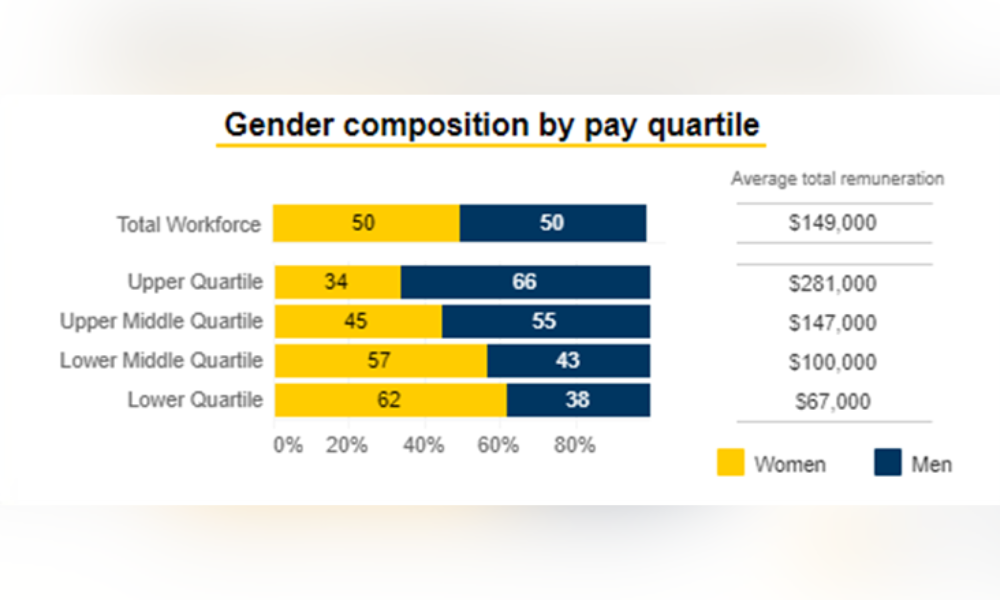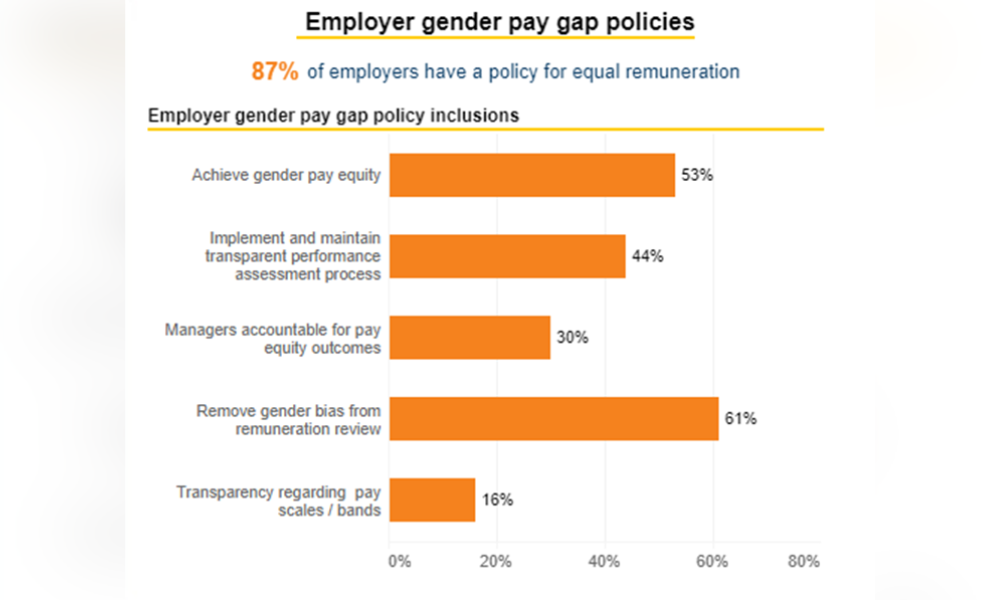

The release of a new report, analysing the gender pay gap and diversity initiatives of companies employing more than five million Australians, has sparked difficult conversations for many businesses.
Under new laws, the data collated by Workplace Gender Equality Agency (WGEA) showed massive differences between what men and women are paid in some of Australia’s largest workforces.
While some fare better than others, the report shows concerning trends as Australia looks to the UK on how to tackle the gender pay gap moving forward.
In Australia, on average, women earned 19% less than men in 2022-23. This is called the gender pay gap.
The WGEA said it was the best way to measure and track gender equality across nations, industries, or within an organisation.
Expressed as a percentage, a positive percentage indicates men are paid more on average than women. A negative percentage indicates women are paid more on average than men.
“While you should strive for a 0% gap, anything between -5% and 5% can be considered acceptable performance,” the WGEA said. “This tolerance threshold accounts for workforce changes which may occur each year.”
For the purposes of this article, the gender pay gap is calculated using the median value rather than the average value. This is because it’s less skewed by outliers such as a high CEO salary.
It also features total remuneration rather than base salary to include superannuation, overtime, and bonuses.
The WGEA said many employers were surprised to discover they had a gender pay gap, as equal pay – paying women and men the same for the same, or comparable, job – is a legal requirement. However, equal pay is not the same as the gender pay gap.
There are many common drivers of the gender pay gap, including:

Across all employer sizes, the finance sector (excluding insurance and superannuation funds) has a gender pay gap of 25.6%. This is among the worst across all sectors.
While the workforce is split 50/50, only 34% of women make up the upper quartile of the industry’s pay scale.
Overall, the vast majority (87%) have a policy in place to ensure equal remuneration, but many financial businesses lack other appropriate gender pay gap policy inclusions.


National Australia Bank (NAB) outperformed the industry
Among the big four banks, NAB had the lowest gender pay gap at 18.8% – which is a 1.8% improvement from last year and 6.8% better than the industry average.
Employing over 32,000 people, NAB said its gender pay gap can be primarily attributed to a higher number of men in senior positions, or in roles with higher pay which is driven by market forces (such as specialist or sales roles).
The bank has significantly improved women’s representation on its board (non-executive directors) increasing it from 38% to 55% over the year.
However, it still has some work to do to address the gap, with only 35% of women making up the upper quartile of pay.
“Driving greater representation of women in leadership roles across all areas of the bank is one of the most sustainable ways to continue reducing the gender pay gap, and a key priority for NAB,” the bank said, in further comments it made for WGEA’s report, which can be found in the WGEA Data Explorer.
“We remain committed to our target of 40%-60% gender balance at all levels of the organisation by 2025.”
NAB also had among the best gender pay gap policies out of the big four banks, being the only major bank to commit to transparency regarding pay scales and bands.
However, it was also the only major bank to not commit to removing gender bias from remuneration reviews.
ANZ’s gender pay gap ‘much higher’ than they would like
ANZ’s gender pay gap was 23.1% for 2022-23, which is 2.5% better than the industry average.
Like the industry overall, despite a majority-female workforce (50.8%), women at ANZ remain underrepresented in leadership positions (37.3%).
The bank identifies increasing female representation in senior roles as crucial to closing the gap. ANZ’s "Women in Leadership" (WIL) action plan has shown progress, exceeding its 2023 goal and increasing representation in both overall leadership and revenue-generating roles.
However, ANZ acknowledges potential challenges in achieving its 2024 target of 38.3%.
“We anticipate the changing shape of our business and increased focus on traditionally male-dominated roles may make it challenging to achieve the progress in WIL that we are seeking,” ANZ said in the WGEA report (add hyperlink to data explorer here)
Additionally, the lack of manager accountability for pay equity outcomes might further impede progress.
Westpac has ‘more work to do’
Westpac, with a gender pay gap of 28.5%, acknowledges the need for improvement as it surpasses the industry average by 2.9%.
While women make up the majority of their workforce (54%), they are primarily concentrated in lower-paying roles like contact centres, operations, and branches. This results in women being heavily represented in the lowest pay group (71%).
“Our gender pay gap is heavily influenced by the shape of our organisation,” Westpac said in the WGEA report (add hyperlink). “Our focus is on improving the gender pay gap by increasing participation of women in senior roles as well as specialist areas such as institutional banking and technology.”
Westpac also championed its remuneration policies and practices, which it said are structured to help people leaders make equitable pay decisions.
“We undertake like-for-like and by-level analysis to identify any potential gender-based pay equity issues. Where differences cannot be explained by a person’s skills, experience, or performance, we take action,” Westpac said in a statement.
“This approach helps ensure that our people are valued and paid fairly. Our average pay equity difference, by organisational level, is approximately 5%.”
However, it must be noted that Westpac does not have pay scale transparency.
“We’re proud to have 49% women in our senior leadership positions, but we recognise there is more work to do,” the bank said.
Commonwealth Bank of Australia posts gender pay gap of 29.9%
Commonwealth Bank (CBA) has the largest gender pay gap among the major banks, with its median total remuneration gender pay gap being 29.9% over 2022-23.
While 56% of CBA’s nearly 50,000-strong workforce are women, 72% work in the lowest pay group.
CBA also has the smallest amount of employer gender pay gap policies among the major banks.
While some policies are aimed at achieving gender pay equality and reducing bias in salary reviews, they lack additional measures that could further promote equal pay. This includes:
CBA did not provide additional comments to the WGEA.
While the major banks have been highlighted for their significant gender pay gaps, it's important to note that they are not alone in this issue.
Second-tier banks also show mixed results, with some demonstrating progress (AMP Bank at 19.9%; Bank of Queensland at 21.9%; Macquarie Bank at 22.1%) and others still having work to do (Bendigo and Adelaide Bank at 24.8%; ING Bank at 32.2%).
Nor is it just exclusive to banks or lenders.
While Pepper Money posted a median base salary gender pay gap of 18.8%, it blows out to 28.5% when looking at median total remuneration.
Liberty Financial’s gender pay gap was a comparatively impressive 15.3% but the data showed the company had no employer gender pay gap policy inclusions.
La Trobe Financial (8.3%) was a positive outlier among the group, while Firstmac (28.1%), Resimac (29.6%), and LMG (23.9%) posted gender pay gaps heavily skewed towards men.
While narrowing the gender pay gap takes time and sustained effort, research has concluded that the publication of employer gender pay gaps acts as an important step in initiating and deepening action on gender equality and making positive change in the workplace.
Economics and policy consultancy firm Mandala explained this phenomenon referencing WGEA’s research into the United Kingdom, where individual firms’ pay gap data has been published since 2017.
Since the UK implemented these changes, the gender pay gap has closed to 14%, which is 5% closer to gender pay equality than Australia.
“As we eagerly digest Australia's gender pay gap data, the UK's journey reminds us that sustained effort, transparency, and proactive measures by employers are key to narrowing the gender pay gap and fostering workplace equality,” a Mandala spokesperson said.
What do you think about the bank’s gender pay gap results? Comment below
